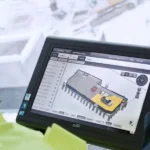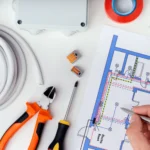This electrical estimating guide is ultra-important for busy contractors and building owners to complete projects under budget.
Accurate calculations in an electrical project matter a lot. Even a minor mistake can make a profitable project into a financial disaster. When all the steps are followed strictly, you can become an expert in electrical estimation. But make sure that every bid you submit is competitive and profitable.
Electrical estimating is one of the most difficult parts of any construction project because it can affect project costs, staffing requirements, and profitability. The precision in the estimation of electrical contractors determines whether they will earn money or face a financial burden
Understanding Electrical Estimating
The calculation of the cost required to complete an electrical project is called electrical estimating. Reading blueprints, figuring out material quantities, evaluating labor needs, and accounting for direct and indirect costs are all interconnected steps in the estimation process. There are various electrical estimating software programs for these purposes.
Electrical estimating is still unique because of the specific knowledge needed, even though it is frequently done in conjunction with other trade estimates like HVAC or plumbing. A reliable Cost Estimating Company always digs deeper into technical and non-technical details to prevent mistakes. So, seeking expert help is better than just guessing!
Types of Electrical Estimates
Two main estimate types are commonly used by electrical estimation services:
- Preliminary estimates are general computations made to determine budgetary constraints and feasibility. These are helpful for preliminary project discussions and early decision-making because they offer a general financial outline without specific itemization.
- A detailed estimate involves thorough analysis of every project expense as part of detailed estimates. These thorough estimates, which include detailed material takeoffs, exact labor costs, and contingencies, are utilized in final bidding procedures. Achieving accuracy and profitability requires knowing which estimate type is best for each stage of the project.
The Step-by-Step Electrical Estimating Process
Step 1: Review Project Specifications Thoroughly
The fundamental point of accurate electrical estimation is in the thorough review of all project documentation, including:
Particular attention should be given to what is defined as contractor qualifications (i.e., quality and experience), payment terms, bonding capacity, and insurance requirements to confirm your compliance with the qualifications.
Look for material grades, installation methods, and who bears the cost of certain low-voltage systems such as fire alarms and communications.
Read the legal language to assure yourself that if you win the project, you’ll be able to live with that language.
Step 2: Analyze Architectural and Electrical Drawings
First, approach all of the drawings from a higher-level approach to see the entire scope of work. Higher-level reads mean looking at architectural and electrical drawings. Professional Electrical Estimating Services are prepared carefully by analyzing every inch of detail.
Working heights, elevations, and building mass configuration will directly inform the impact on labor and material pricing and equipment needs for the project.
Step 3: Perform Material Takeoff
The material takeoff is the most time-consuming part of electrical estimating. The takeoff process requires counting and measuring items displayed on electrical drawings, such as:
- Light fixtures and luminaires
- Receptacles and switches
- Conduit runs and raceways
- Panels and electrical gear
- Wire and cable
- Junction boxes and fittings
Modern electrical estimating software can help streamline the process of takeoff with digital takeoff capabilities and save you time. Digital takeoff and estimating tools allow you to count and measure items in PDF drawings, which eliminates a lot of the math and potential for making errors. There are even features that have auto-count and symbol recognition that could save you hours of manual measuring and counting.
Step 4: Calculate Labor Cost
Contractors can price labor units using two main methods:
- Shop Average Labor Rate: This measure computes the total costs incurred by field laborers over the last twelve months and divides it by the total field man-hours during such period. It provides a general average, but there could be differences among residential, commercial, and industrial jobs.
- Job Average Labor Rate: This one is really more accurate but is rather labor-intensive in the calculations, requiring such estimations–for the specific construction endeavor–for crew makeup, which would factor the skills and experience levels that are required.
Step 5: Equipment and Other Direct Costs Calculation
Include costs for:
- Allotting small tools for the job.
- Project management and supervision.
- Non-productive labor.
- Temporary power and lighting.
- Site-specific requirements.
Step 6: Create the Final Bid Proposal
Once all costs are calculated, prepare a comprehensive bid proposal that clearly details:
- Scope of work included
- Specific exclusions
- Payment terms and schedule
- Project timeline
- Material specifications
- Warranty information
Conclusion
Hopefully, your concepts are clear through is detailed electrical estimating guide. However, electrical estimating is a process of technical specification, which touches on details and entails a lot of business. You need to understand more than just the nature of the work; in order to succeed, you need to understand market conditions, the factors affecting labor productivity, and the range of items affecting project costs. Cost estimating companies would be able to put together very accurate figures that create a competitive edge for profitable business activities while going through each step set out in this guide, from project selection through final proposal submission, using modern estimating tools.




